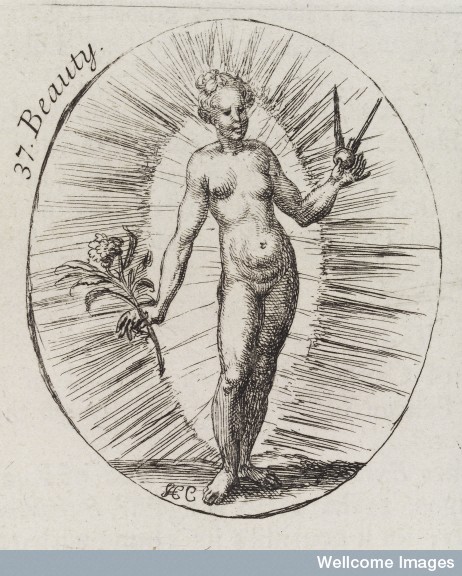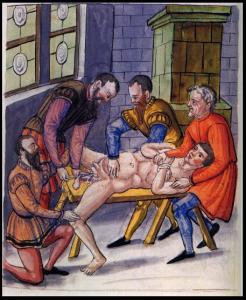
This blog post is really an addition to the Beautiful Healthy Bodies post from January. In that blog post I discussed the connections between physical appearance and disease. The blog started by discussing the connections between venereal disease, appearance and morality. Venereal disease could be an obvious bodily affliction causing pustules, hair loss, a pale complexion, dark circles under the eyes and problems with the mouth and nose. (For more information on living with a venereal disease see Lisa Smith’s excellent post http://www.sloaneletters.com/suffering-venereal-disease-in-the-early-eighteenth-century/) Moreover, as we know, this disease was associated strongly with immorality and illicit sexual behaviour. Men caught it by having sex with harlots and foul women. So being visibly afflicted with the French Disease meant that you could be both physically and morally unattractive.
But it would appear that for at least one early modern surgeon there was a secondary level of connections between beauty and the pox. John Browne explained to readers of The Surgeons Assistant that beauty caused you to catch the disease, or for it to manifest more strongly in the body.1 Conversely he explained ugly people were less likely to catch a venereal disease; and not only because of their reduced chances of securing a sexual partner.
sexual partner.
Medical theory in the early modern period postulated that sexual desire and pleasure were intimately bound into the body’s heat, which increased during arousal. This heat was vital for reproduction and caused bodies to be fertile. But, heat was also thought to be a contributing factor to corruption of venereal disease. In the seventeenth century some medical writers argued that the disease could be bred spontaneously in a woman’s body if she had sex with multiple partners. They argued that the seed from these encounters would mix in her, which was importantly hot, womb and putrefy into a dangerous contagion that would then be passed onto the next man she happened to be with. Brown mixed these ideas of heat, desire and contagion to suggest that:
‘and another reason hereof may be also, that those who do mostly exercise themselves thus with impure Women, and do with most heat and lustful desire (meeting with Women of their own Kidney, answering their letchery,) entertain them in their Embraces, they are seen sooner infected with this disease, than those that proceed with less vigour and heat; and this is made good, in shewing the difference between those that are handsome and those that are ugly, where we may suppose, as the first by their charming Beauty may increase the flame, the other as ready is seen to extinguish it.’2
Thus, he suggests that because ugly sexual partners will raise less desire and pleasure during intercourse, the heat of the action will be minimised. This in turn would offer some protection from the ravages of venereal disease, which may have served only to increase the persons perceived unattractiveness. Taken to an extreme conclusion Browne’s theory could suggest that the beautiful were more likely to become the ugly whose previous charming beauty was marred by pox marks, scars and hair loss.
John Browne was not alone is considering the consequences of sex with an ugly partner. In the eighteenth-century medical treatise Conjugal Love Reveal’d Nicholas Venette also asked ‘ If there is greater inconveniency in kissing an Ugly Woman than a Pretty one.’ 3 Unlike Browne, Venette did not spend much time considering the benefits of this situation but rather lamented that an ugly partner would cause men to experience sexual dysfunction: ‘ugliness calms all our Raptures; far from exciting us to Love, it rather makes us to abhor all its Pleasures. If peradventure we are obliged to approach an ugly Woman, our secret Parts slacken rather than stiffen’.4 He cautioned that attempting to engage in intercourse with an unattractive woman could cause ‘strange Accidents’ and would result in the birth of children who were ‘dull’.5 In the end Venette concluded that there were no benefits to taking an ugly partner and instead warned his readers to select a bride who was neither too beautiful or too ugly:
‘Were I to advise any one to marry, I should exclude both the Handsom and the Ugly, The first is apt to be imperious, and will sooner be common than particular. The other will cause Repentance and may be Divorcing. except the Husband is endowed With particular Vertues’.6
It would seem then, for some medical authors, that the beauty of your sexual partners, and marriage partner, was a matter of health that could have severe consequences. One the one hand beauty could lead to venereal disease but on the other ugliness could lead to impotence and doltish offspring.
__________________________
1 John Browne, The Surgeons Assistant. In which is plainly discovered the True Origin of most Diseases. Treating particularly of the Plague, French Pox, Leprosie, &c. … (London, 1703).
2 Ibid, p.63.
3 Nicholas Venette, Conjugal Love Reveal’d … (London, 1720?), p, 162.
4 Ibid, p. 165.
5 Ibid, pp.166-7.
6 Ibid, p.168.
© Copyright Jennifer Evans. All rights reserved.




This is fascinating. If there was a feeling that diseases could manifest spontaneously because of impure thoughts then it’s another reason why women might be reluctant to see a doctor for other, non-sexual ailments. Thanks for posting.
Indeed, there is a fair bit about this seventeenth century theory on the sort of general text books on venereal disease – I had my second years look at it last year as a discussion about gendered narratives of sexual diseases. I’m not sure how far it was considered as a reality beyond a general theory but it fitted with ideas about the spread of syphilis through a range of ‘immoral’ women, those who were promiscuous, unclean wet nurses etc.
It might be useful to consider discussions of the disfiguring effect of smallpox, among medical writers and others.
Henry Sidney was probably exagerating, being bitter about his fall from royal favour, but even so there was surely a degree of plausibility when he wrote of his wife —
“When I went to Newhaven, I lefte her a full faire Ladye in myne eye at least the fayerest, and when I retorned I found her as fowle a ladie as the smale pox could make her, which she did take by contynuall attendance of her majesties most precious person (sicke of the same disease) the skarres of which (to her resolute discomforte) ever syns hath don and doth remayne in her face, so as she lyveth solitairilie sicut Nicticorax in domicilio suo, more to my charge then if we had boorded together as we did before that evill accident happened.”
More well know is the remark of Fulke Greville, who wrote of her that “she chose rather to hide herself from the curious eyes of a delicate time than to come upon the stage of the world with any manner of disparagement.”
Indeed this might make a very interesting counterpoint. In my new project I am predominantly considering sexual health disorders so I haven’t read much on small pox, but I definitely think that if I end up exploring defomity and beauty further it would be interesting. Again I wonder if these were seen as more problematic in women, where beauty is a greater asset, do they think about these as being detrimental to men’s lives.
For men’s beauty, one might consider the long history of rhinoplasty.
I have wondered why, when he contracted gangrene after the battle of Zutphen, Sir Philip Sidney (son of the above-mentioned Lady Mary) and his uncle Leicester did not consider amputation. There must surely have been a competent military surgeon available. One possibility is that a major surgical intervention, whether to remove the bullet in his thigh or to take off the entire leg, would permanently ruin his career as a courtier. He would now longer be able to make a long leg when bowing to the Queen.
There are surely some good contemporary accounts of his deathbed.
Yes, I think there is still much more we need to uncover about the relationship between men’s health and their appearance. In terms of gangrene I think it has to be remembered that amputation was not a certain route that would ensure health. In all of the surgical literature I have read it is an absolute last resort because it was both painful and very dangerous. It would be interesting to consider the tensions between living with something as disasterous as gangrene and the fear/uncertainty of undergoing amputation. It would seem from some of the amputation narratives that surgeons presented themselves as saviours swooping in at the very last moment to remove the limb and save the patient’s life, in these cases it would seem that patients and their families were very reticent about undergoing this type of operation. This may be a question to put to http://thechirurgeonsapprentice.com/